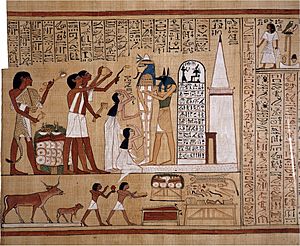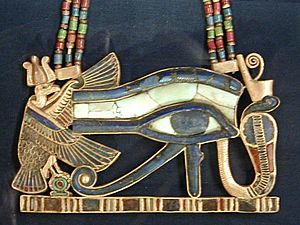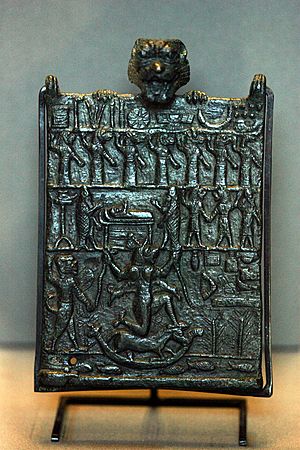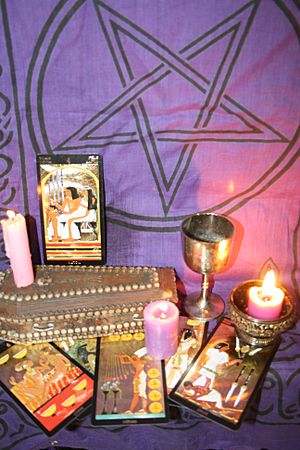Magic (supernatural) facts for kids
Magic is a belief that you can influence the world using special powers or rituals. People sometimes call it magick to tell it apart from stage magic, which is just tricks.
This article talks about supernatural magic, not the kind you see at a magic show. It will guide you through different magical traditions and practices. We'll also look at how magic is used in fiction, like in books and movies.
Contents
The History of Magical Beliefs
People have believed in and practiced magic in many cultures and religions throughout history.
Some major religions, like Judaism, Christianity, and Islam, officially see magic as witchcraft. However, ideas about magic have still been present within these religions for a long time. When these views were applied to other religions, it often made people like tribal shamans seem bad.
Older traditions, like shamanic and polytheistic beliefs (where people believe in many gods), usually didn't have problems with other supernatural beliefs.
Over time, there have been many attempts to stop magical beliefs. Examples include early Hebrews removing polytheistic tribes, the Catholic Church trying to change pagan holidays, and the Salem witch trials. During these times, magic often became hidden or secret. People who wanted to keep the traditions alive often used disguised or symbolic ways. This is how the term occult came about.
Different Kinds of Magic

Magic practices can be divided into two main types. The first is divination, which means trying to find out information. Some ways people try to do this include:
- astrology (studying stars to predict the future)
- augury (predicting the future from signs)
- cartomancy (fortune-telling with cards)
- dowsing (finding water or minerals)
- fortune telling (predicting the future)
- geomancy (divination using patterns on the ground)
- I Ching (an ancient Chinese divination text)
- omens (signs of future events)
- tarot cards (special cards used for divination)
Necromancy involves talking to spirits. This can be to get information from them or to command them. If you command spirits, it falls into the second type of magic: casting spells. This broad category includes many specific magical goals. For example, there's weather magic like the rain dance, or physical magic like alchemy (turning metals into gold), or making potions.

Another way to sort magic is by "traditions." These are groups of magical beliefs and practices linked to different cultures. These traditions can include both divination and spells. Some examples are:
- hermeticism
- hoodoo
- New Age
- pow-wow
- ritual magick
- Santeria
- Vodun
- Wicca
Some of these traditions are very specific to a culture. Others mix ideas from many places. When we talk about magic as a tradition, it can sometimes be hard to tell the difference between magic and folk religion.
Magic in Stories and Books
Magic has been a popular subject in fiction for a very long time. It often works as a plot device, meaning it helps the story move forward. Magical artifacts and quests to find them are common in stories.
Magic has been a main part of fantasy fiction since ancient times. You can find it in old tales like those by Homer and in stories about the Holy Grail. It also appears in classic books like The Faerie Queene by Edmund Spenser. Modern authors like J. R. R. Tolkien, Mercedes Lackey, and J. K. Rowling also use magic in their works.
Sometimes, fictional magic can even inspire real-life magical practices. For example, the Necronomicon was a made-up book by H. P. Lovecraft. But he wrote about it so well that some people later tried to create this "fabled" book of magic.
Modern Believers in Magic
Many people today believe in or practice different forms of magic. These modern forms are often based on old writings or ideas.
People like Aleister Crowley are often given credit for bringing magical traditions back into popular use in the 20th century. However, in their efforts to rebuild old traditions, they sometimes added things that weren't truly ancient or even made things up. Other similar movements happened around the same time in France and Germany.
Today, many traditions that connect with nature, seasons, and the Earth are called Neopagan. It's hard to say one is more "real" than another.
Aleister Crowley liked to spell magic as magick. He said it was "the science and art of causing change to occur in conformity with the will." This meant he included everyday actions, not just rituals. He even said that a simple act like a man blowing his nose could be a magical act if it was done with intention.
While some modern magic users prefer the term pagan, Neopaganism is more accurate for describing current rituals. Wicca is a more organized form of modern magic. It also got many ideas from Crowley. Wicca and Neopaganism are very different from Satanism, which gets its ideas from twisting monotheistic religious texts.
How Do People Think Magic Works?
People who believe in magic often think it works in one or more of these ways:
- Hidden Natural Forces: They believe there are natural forces that science cannot detect yet. These magical forces exist alongside the four known forces of nature (gravity, electromagnetism, strong nuclear force, and weak nuclear force).
- Mystical Power: Some believe in a special power, like mana, that exists in everything. This power is sometimes thought to be dangerous.
- Cosmic Connection: They think there's a mysterious link in the universe that connects everything, beyond normal natural forces.
- Symbol Manipulation: People who believe in magical thinking think that symbols can do more than just represent things. They believe symbols can magically take on the qualities of the real thing they represent. By changing symbols, they believe they can change reality.
- Laws of Similarity and Contact: These ideas come from Sir James George Frazer's book The Golden Bough.
- The "law of similarity" means that like affects like. For example, a doll made to look like someone might be used to affect that person.
- The "law of contact" or "contagion" means that things that were once in contact can still affect each other. For example, using a lock of someone's hair in a spell.
- Concentration or Meditation: Some believe that focusing your mind on an idea or goal can lead to a special experience. Magic, in this view, helps you focus your attention to achieve that goal.
Magical Practices

The main tool in magical practices is the spell. A spell is a spoken or written set of words used with specific items. If a spell is done correctly but doesn't work, some might say the spell itself is fake. However, most often, people believe the spell failed because the person doing it didn't follow the instructions exactly.
Generally, there are two types of magic: contagious magic and sympathetic magic.
- Contagious magic uses physical items that were once in contact with the person or object you want to influence.
- Sympathetic magic uses physical objects that look like the person or object you want to influence.
Religious Rituals and Magical Thinking
From a non-religious point of view, many religious rituals and beliefs can seem similar to magical thinking.
Religious supplication is related to both magic and prayer. This is when someone offers a prayer or even a sacrifice to a god or spirit. They then ask this god to help them.
The main difference is that prayer needs the god to agree, and the god can say no. Magic, however, is thought to work:
- Because the ritual itself makes it happen.
- Because of the magician's strong will.
- Because the magician believes they can command spirits.
In practice, if a prayer doesn't work, people might say the god chose not to grant it. If magic fails, it's usually blamed on a mistake in how the spell was cast. This is why magic often has very strict rules and steps, unlike prayer, which can be more spontaneous. Following the ritual perfectly is key to success in magic.
Magic in History and Archaeology
Evidence of some form of shamanic contact with the spirit world appears in almost all early human communities. This includes aboriginal tribes in Australia, rainforest tribes in South America, and ancient groups in Europe.
Ancient cave paintings in France are often thought to be early magical rituals. People believe they were meant to bring successful hunts. Many ancient Babylonian and Egyptian writing symbols also seem to come from similar magical ideas.
Over time, some communities changed from being nomadic (moving around) to agricultural (farming). With this change, spiritual life also changed. Just as tribal elders became kings, shamans became priests.
This was a big shift. A shaman's job was to connect the tribe with the spirit world, helping the tribe as they wished. A priest's job was to deliver instructions from the gods to the people, as the gods wished. This change meant that magic became less direct for the people. It was at this stage that very detailed rituals, which set the stage for formal religions, began to appear. Examples include the funeral rites of the Egyptians and the sacrifice rituals of the Babylonians and Mayans.
Images for kids
-
One of the earliest surviving accounts of the Persian mágoi was provided by the Greek historian Herodotus.
-
Hecate, the ancient Greek goddess of magic
-
Many concepts of modern ceremonial magic are heavily influenced by the ideas of Aleister Crowley.
See also
 In Spanish: Magia para niños
In Spanish: Magia para niños














